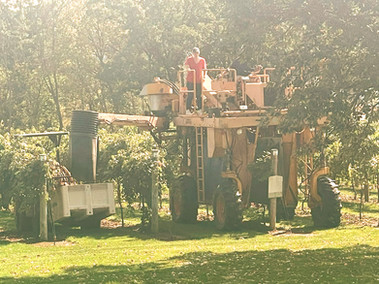What the heck are cold-hardy grapes?
- Allison Sheardy
- Oct 10
- 3 min read
I think I’ve alluded to my actual, paying job a few times throughout this blog, although it certainly hasn’t been the focus. My wine career started about a decade ago, born from a lifetime love of food and fine dining that morphed to encompass wine as well. I’ve mainly worked in the hospitality sector of the industry, for producers (rather than restaurants or other venues), especially boutique, family-owned wineries in niche regions. Of course, my wine education journey has happened concurrently with my career, but as you know, that’s another story for another time.
Now, I work for a winery in Minnesota, outside of the Twin Cities. Wait, a winery in Minnesota? Is that even a thing? Yes, actually – there are a growing number of wineries throughout the Midwest. I’ve been here for five years (since the winery opened) and in addition to my duties managing the tasting room, I’ve moved into a part-time production role as well. We have about 20 acres of estate grapes, and we make several thousand cases of wine annually. But here’s the thing – you’re not going to find Chardonnay or Cabernet Sauvignon planted here. The extreme climate (I’ve experienced January days as cold as -40F, with the wind chill) and very short growing season is not conducive for vitus vinifera grape varieties.
As a quick recap, the vast majority of winemaking grapes grown throughout the globe are part of the vitus vinifera species. This includes Chardonnay, Pinot Noir, Sangiovese, Riesling, and so on. These varieties are generally recognized as the best option for high quality winemaking, due to both chemistry (pH, acidity, ability to accumulate sugars) and the aroma and flavor compounds they contain. However, these grapes generally thrive in a fairly mild climate, which limits their areas of production. There are other grape species found around the planet, however, that are adapted to survive in their native areas. These grapes tend to make less than delicious wines, with a deep grapey flavor (sometimes referred to as ‘foxy’) that is not as appealing to the modern palate. Different universities and research institutions have spent decades creating hybrid grapes – ones that have parentage in both native species and vinifera species – to end up with brand new varieties that can thrive in a region's given climate and make delicious wines. In Australia, they are focused on hot hardy varieties, while in Europe the emphasis is on creating disease resistant varieties. Here in Minnesota, the University of Minnesota breeds cold-hardy varieties. As a side note, a lot of the non-vinifera varieties are resistant to various grape pests and diseases (this is why American rootstock provided a solution to the phylloxera crisis), making this an interesting pathway toward reducing vineyard sprays.
With all of that said, at the winery I work for, we have eight different cold-hardy grape varieties planted – Marquette, La Crescent, Itasca, Frontenac Noir, Frontenac Blanc, Frontenac Gris, Brianna, and Petite Pearl. We craft a wide array of wine styles – white, rosé, and red, from dry to dessert. We’re just wrapping up harvest for the season, so I thought I’d share a few snaps!
Top left: We machine harvest all of our grapes, for efficiency and to reduce the time between picking and press. Top right: Here I am raking Itasca grapes into the press. Below: Glamour shots of the vineyard.
Currently listening to: Sufjan Stevens. I'm all about the vibe these days.
Currently drinking: Starbucks Fall Blend coffee (but none of that pumpkin spice garbage)













Comments